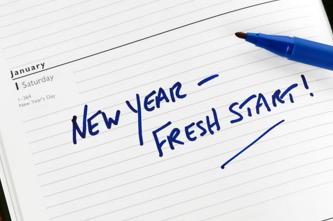Do you ever wonder what would happen if everyone kept their New Year’s resolutions? If I had to hazard a guess, I’d say there would be 23 million pounds of collective weight loss, 536,201 people learning new languages, 760,000 more hours spent with our families, 5 million fewer smokers, 60,000 more hours of volunteer work performed, and 31,746 educational degrees finally completed.
Since we are only human, and resolutions are notoriously difficult to keep, it’s no surprise that many resolutions get repeated – rolled over, if you will – from year to year. If you didn’t stick with it last year, you have a fresh, new chance for this year. How wonderful is that?
For a list of popular New Year’s resolutions around the U.S. – and links to help you achieve them – click here.
And did you ever wonder how it all got started, or whether the practice is observed around the world?
Four thousand years ago, Babylonians marked the start of a ‘new year’ around the vernal equinox. For 11 days, various rituals were observed during Akitu, a religious festival whose name comes from the word for barley.
All this was before the Gregorian calendar, or even before the Julian calendar, which Julius Caesar established when the early Roman calendar fell out of alignment with the sun’s seasons. Caesar marked the beginning of the year on January 1, with a nod to Janus, the Roman god of beginnings.
Today, the celebrations begin on December 31, so that revelers are awake to mark the transition to a new year. How this is marked varies around the world, but typically involves food and drink – sometimes specific food and drink thought to bring good luck for the year ahead. Some of these include grapes in Spain, lentils in Italy, pork in Hungary, circular baked goods in the Netherlands, and rice pudding with a hidden almond in Sweden.
Fireworks, songs, and general merriment are the norm among crowds that gather to usher in the New Year. In New York, a million people assemble at the “Crossroads of the World” to watch a ball made of more than 2600 Waterford crystal triangles descend from a spire atop One Time’s Square at midnight. Millions more watch this 106-year-old tradition on television. Several other cities stage similar – albeit smaller – events.
Of course, not everyone’s New Year celebrations occur on January 1. The Chinese New Year, based on the lunar calendar, falls on January 31 in 2014. Many of the traditions of the Chinese New Year come under the heading of “fresh start.” Houses are cleaned, old items replaced with new (especially clothes), debts are paid, respects are offered to the Kitchen God, ancestors are revered, and families are reunited. It is a time to consult the feng shui master and to court good fortune for the year ahead with auspicious words and actions.
In addition to China, Hong Kong, Macau, Taiwan, Singapore, Thailand, Indonesia, the Philippines, and Malaysia are some of the other countries with Chinese New Year celebrations.
Each Chinese year is represented by a different animal on a 12-year cycle. If the New Year animal is the same as that of your birth year, you are especially fortunate. In 2014, revelers will welcome the Year of the Horse. Characteristics associated with the horse are determination, endurance, vitality, spirit, warmth, intelligence, and ability.
Those sound like traits many of us would aspire to… Maybe we’re not done with our resolution lists after all!
Wishing you a strong resolve to keep those resolutions!

